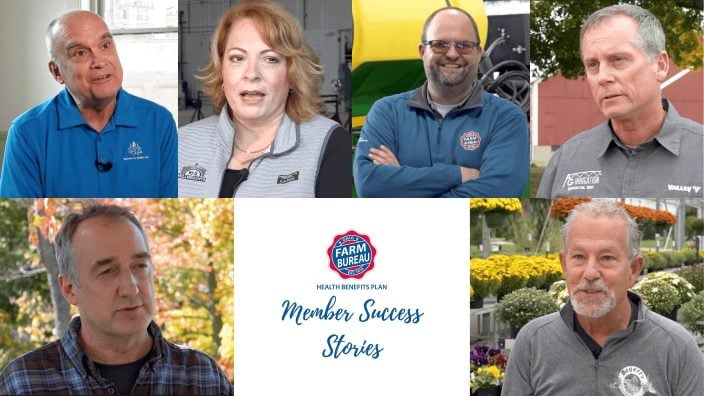Farmer’s Guide to Trucking Regulations available to Ohio Farm Bureau members
The guide includes a farm driver checklist, overview of state and federal regulations and exemptions, CDL qualifications and more.
Read More
We still have a strong dairy industry in this area.
Granted, the number of dairy farms is just a fraction of what it was 40 or 50 years ago, but those still in business are much larger and more efficient than those of the 1950s or ’60s.
For the past four or five years, dairy farmers have had a difficult time with depressed prices for their milk. Prices have been lower than the cost of production for many. The cost of producing milk depends on the efficiency of individual farms, but has caused all of them to tighten their belts.
The outlook for 2019 is not much better than last year, and it is discouraging for all dairy farmers. The new farm bill does have a number of programs available to help the situation. The problem is they are complicated, and some economists feel they are too complicated for USDA and insurance agents to evaluate in time to help dairy farmers decide what to buy.
As part of the farm bill, dairy farmers can take part in three programs. These include Livestock Gross Margin (LGM-Dairy), Dairy Revenue Protection (Dairy-RP) and Dairy Margin Coverage (DMC). According to some economists, dairy farmers can enroll all of their production in the DMC plus either the LGM-Dairy or Dairy-RP.
USDA’s Farm Service Agency manages DMC and the other two are administered by USDA’s Risk Management Agency. This arrangement makes overall administration more difficult.
There is concern this will make it difficult for dairy farmers to study, evaluate and decide in which, if any, of these programs they should enroll. Which one or ones will help them the most? They can potentially be in all three programs.
If farmers need to borrow money, their lenders need to be aware of the options farmers have under these new farm bill risk management programs. They could possibly be an important factor in making loan decisions.
Some important USDA implementation resources and information were delayed during the recent government shutdown. Because of this, dairy farmers and their lenders might not be aware of the benefits they potentially could receive under these dairy safety net programs. This could affect terms of the loan or the farmers’ ability to get a loan.
Dairy safety net programs were passed with the intent of helping the distressed situation dairy farmers are and have been in for several years. They need to take a hard look at what is available to make a decision about taking part in some or all of the programs.
It is unfortunate that information has been delayed and making a decision has become more difficult. Dairy farmers don’t want to miss any potential benefits from farm programs. Yet when it gets too difficult and cumbersome to enroll, some may shrug their shoulders and say they won’t enroll.
That would be unfortunate because given the current outlook, farm families will need all the help that is available to them. Available information indicates about 275 Ohio dairy farms went out of business in the past year. Locally, we haven’t had much loss, which indicates a strong group of dairy farmers. But they can continue only so long without some help.
Probably the best place to start for help is your local Farm Service Agency (FSA). Trumbull County’s FSA Office is located in the Ag Center in Cortland. Extension educators located in OSU Extension offices are another source of information.
Getting signed into some government programs isn’t always easy, but it may be worthwhile to take the time to get enrolled. So a visit to your local FSA office could be worthwhile if you are a dairy farmer. Take advantage of any help that is available.
Submitted by John Parker, an independent agricultural writer for Farm Bureau.
OFBF Mission: Working together for Ohio farmers to advance agriculture and strengthen our communities.


The guide includes a farm driver checklist, overview of state and federal regulations and exemptions, CDL qualifications and more.
Read More


ODA will enroll 500,000 acres into the program for a two-week sign-up period, beginning April 22, 2024, through May 6, 2024. Contact local SWCD offices to apply.
Read More

Katie Share of Columbus has been named ExploreAg and Youth Development Specialist for Ohio Farm Bureau.
Read More

Mary Klopfenstein of Delphos has been named Young Ag Professional and Ag Literacy Program Specialist for Ohio Farm Bureau.
Read More

The plan has been updated to give sole proprietors access to more rate stability and a smart solution that offers potential savings on health care.
Read More

The American Farm Bureau Federation, in partnership with Farm Credit, is seeking entrepreneurs to apply online by June 15 for the 2025 Farm Bureau Ag Innovation Challenge.
Read More

Adele Flynn of Wellington has been elected treasurer of the Ohio Farm Bureau Federation and now holds the third highest elected office in Ohio’s largest and most influential farm organization.
Read More

Producers are urged to work with their veterinarian to practice enhanced biosecurity measures and review and limit cattle movements within production systems.
Read More

The changing seasons bring with them the need to thoroughly inspect pole barns for any damages that may have occurred during the winter months.
Read More

Hundreds of Ohio businesses and sole proprietors are raving about Ohio Farm Bureau’s Health Benefits plan with lower, predictable costs and easy enrollment and administration options.
Read More